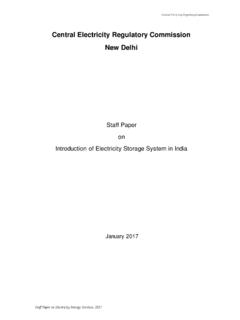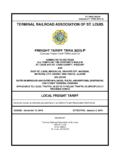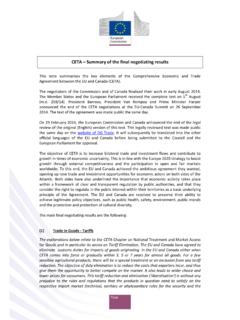Transcription of CERC (Terms and Conditions for Tariff determination from ...
1 1 Statement of Objects and Reasons on CERC (Terms and Conditions for Tariff determination from Renewable Energy Sources) regulations , 2009 CERC (Terms and Conditions for Tariff determination from Renewable Energy Sources) regulations , 2009 Statement of Objects and Reasons 1. Introduction The Electricity Act, 2003 (hereinafter referred to as the Act ) under Section 79 assigns the following functions to the Central Electricity Regulatory Commission (hereinafter referred to as the Commission ), among others: a) to regulate the Tariff of generating companies owned or controlled by the Central Government; b) to regulate the Tariff of generating companies other than those owned or controlled by the Central Government specified in Clause(a), if such generating companies enter into or otherwise have a composite scheme for generation and sale of electricity in more than one State; Further, Clause of Tariff Policy entrusts the responsibility on the Central Commission to frame guidelines for pricing of non-firm power especially from non-conventional sources for the cases when procurement is not through the competitive bidding process.
2 Section 61 of the Act empowers the Commission to specify, by regulations , the terms and Conditions for the determination of Tariff in accordance with the provisions of the said section and the National Electricity Policy and Tariff Policy. In terms of clause (s) of sub-section (2) of section 178 of the Act, the Commission has been vested with the powers to make regulations , by notification, on the terms and Conditions of Tariff under section 61. As per section 178(3) of the Act, the Central Commission is required to make previous publication before finalizing any regulation under the Act. Thus as per the provisions of the Act, the Central Commission is mandated to specify, through notification, the terms and Conditions of Tariff of the generating companies covered under clauses (a) ,and (b) of sub-section (1) of section 79 of the Act after previous publication.
3 In exercise of the powers vested under sections 61 and 178 (2)(s) of the Act and all other enabling powers and in compliance of the provisions of Clause of the Tariff Policy and the requirement under section 178 (3) of the Act, the Central Commission 2 Statement of Objects and Reasons on CERC (Terms and Conditions for Tariff determination from Renewable Energy Sources) regulations , 2009 issued vide public notice no. (201)/2009-CERC dated 15th May, 2009 the draft of Central Electricity Regulatory Commission (Terms and Conditions for Tariff determination from Renewable Energy Sources) regulations , 2009 (hereinafter referred to as the draft regulations ) along with explanatory memorandum for comments/ suggestions/ objections thereon.
4 Subsequently, the amendment in draft regulations was made by the Commission to incorporate the norms for Solar PV and Solar Thermal technology. The draft of Amendments, consolidated draft Renewable regulations and explanatory memorandum was issued vide public notice no. (201)/2009-CERC dated 1st July, 2009 for comments/ suggestions/ objections thereon. Subsequently, public hearing was held on 22nd July 2009 to hear views of all the stakeholders and consumers, if any. A statement indicating in brief the comments received from various stakeholders is enclosed as Annexure-I.
5 The list of participants in the public hearing held on 22 July, 2009 is enclosed as Annexure-II. 2. Consideration of the views of the stakeholders and analysis and findings of the Commission on important issues Comments on Definitions 3. Definition of Interconnection point In the draft regulations , the inter-connection point for projects based on different RE technologies was specified. BEST undertaking suggested that definition of inter-connection point should be in accordance with the definition mentioned in the Competitive Bidding Guidelines and Case -1 Standard Bidding Documents issued by Govt of India: Interconnection Point shall mean the point where the power from the Power Station switchyard bus of the seller is injected into the interstate/intrastate transmission system (including the dedicated transmission line connecting the Power Station with the interstate/intrastate transmission system).
6 The Commission is of the view that the issues of evacuation and grid connectivity in case of renewable energy projects with their smaller project/unit size and characteristic features need to be addressed, if more and more renewable energy generation is to be 3 Statement of Objects and Reasons on CERC (Terms and Conditions for Tariff determination from Renewable Energy Sources) regulations , 2009 harnessed. The Commission also observes that in most of the States, responsibility of licensee and project developer in developing the evacuation infrastructure for RE projects varies considerably. In most of the cases, inter-connection point stretches up to nearest grid sub-station and associated cost for development of such evacuation infrastructure is required to be borne by the project developer.
7 The Commission considers that responsibility of project developer and licensee towards developing the evacuation infrastructure should be clearly demarcated. Therefore, for providing clarity on this critical issue, the inter-connection point has been defined in the regulations . Further, definition of interconnection point needs to specifically address requirements of Renewable Energy projects. Accordingly, Interconnection Point in respect of each RE technology has been defined separately. 4. Definition of Non-firm Power Some of the stakeholders suggested bringing energy generation from biomass power also under the ambit of non firm power.
8 The term non-firm power has not been defined under Electricity Act 2003 or Tariff Policy. As a result the interpretation of the term assumes significance. One reasonable interpretation of the term non-firm is the power that cannot be scheduled. Forum of Regulators (FOR) under its Report on policies for renewables has referred to MNRE s (Ministry of New and Renewable Energy) suggestion that renewable energy sources such as wind energy, solar, small hydel etc. may be treated as Non-firm RE sources. However, in case of biomass power (above 10 MW) and non-fossil fuel based co-generation, the electricity generation can be very well scheduled, if fuel management chain is adequately established and the same may be treated as firm RE sources.
9 Further, the Commission clarifies that principles for preferential Tariff determination have been specified for all types of RE sources, whether firm RE or non-firm RE, as the case may be, under the said RE Tariff regulations . 5. Definition of Renewable Energy Sources In the draft regulations , following definition was provided for renewable energy sources: Renewable Energy Sources means renewable sources such as mini hydro, wind, solar including its integration with combined cycle, biomass, bio fuel cogeneration, urban/municipal waste and other such sources as approved by the MNRE; 4 Statement of Objects and Reasons on CERC (Terms and Conditions for Tariff determination from Renewable Energy Sources) regulations , 2009 The Transparent Energy Systems Private Limited submitted to include Industrial wastes of all types solid, liquid and gaseous in the definition of Renewable Energy Sources.
10 Tamil Nadu Electricity Regulatory Commission suggested that word non-conventional energy sources should also be defined, and heat energy generated from the chemical reaction of NCES sources may also be included in the scope of regulations . The Commission is of the view that the definition of Renewable Energy Sources provided in the regulations is very broad as it covers all RE technologies approved by MNRE. Besides, industrial waste based on fossil fuels cannot be covered under realm of RE sources. However, industrial waste based on non-fossil fuels has been covered ( bagasee based cogeneration) subject to fulfilment of Eligibility Criteria as stipulated under the regulations .


















